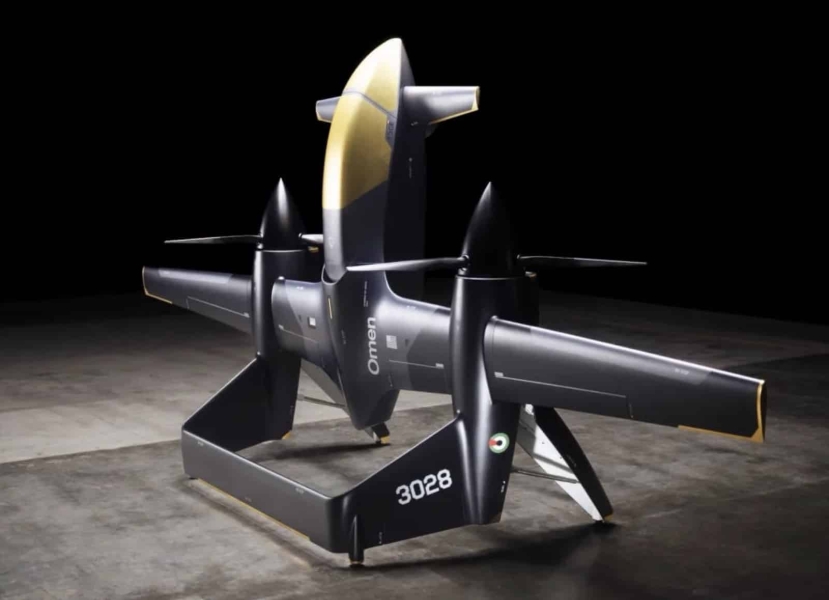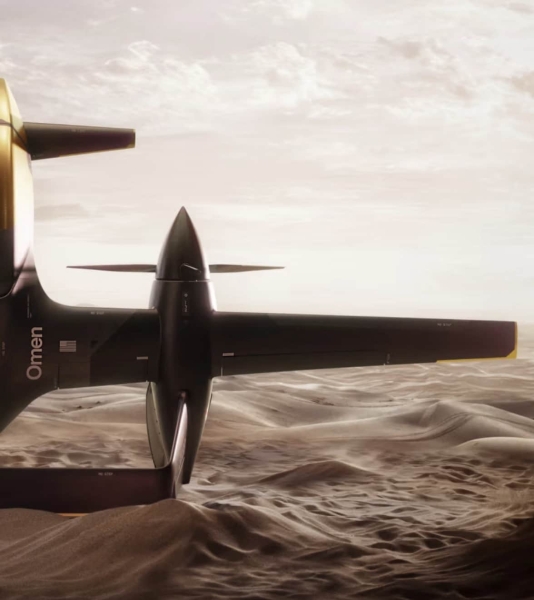Anduril And UAE’s EDGE Group Launch $200M Joint Venture To Mass-Produce Omen Hybrid VTOL Drone

DroneXL Exclusive: Up To $40 Off Skyrover X1, S1 Drones With Amazon Prime Delivery
Anduril Industries and the United Arab Emirates’ EDGE Group announced a landmark defense technology partnership on November 13, 2025, establishing the EDGE-Anduril Production Alliance to co-develop and manufacture autonomous aircraft for Middle East markets. The joint venture centers on Omen, a hybrid-electric vertical takeoff and landing drone that Anduril founder Palmer Luckey has championed as a personal project since 2019.
The UAE has already committed to purchasing the first 50 Omen systems, providing a guaranteed production base that anchors the new Abu Dhabi manufacturing facility. EDGE is investing $200 million in the partnership, building on Anduril’s $850 million internal investment in Group 3 VTOL development and mission autonomy technology.
Revolutionary Tail-Sitting Design Solves Five-Year Engineering Challenge
Omen represents a breakthrough in autonomous aircraft design, combining vertical takeoff capabilities with fixed-wing efficiency through a tail-sitting configuration. The drone stands approximately 10 feet (3 meters) tall, takes off vertically like a helicopter, then transitions to horizontal flight using sailplane-style wings and twin-boom propellers.
“We hit a wall when it came to propulsion technologies,” Shane Arnott, Anduril’s senior vice president for programs and engineering, told reporters. “So we’ve been working very diligently over the last five years, looking at new technologies, and in particular series hybrid tech, and working with the likes of Archer.”
The propulsion breakthrough came through Anduril’s December 2024 partnership with Archer Aviation, a commercial eVTOL developer. Omen uses a hybrid-electric system where electric motors power the rotors while a combustion engine serves as a generator, enabling extended endurance without the weight penalties of pure battery systems.
Classified in the Group 3 category—aircraft weighing between 55 and 1,320 pounds (25-600 kg)—Omen occupies the heavier end of this range. Arnott indicated the drone’s payload capacity runs three to five times higher than typical Group 3 systems, which generally carry 25-50 pounds (11-23 kg).
UAE Emerges As Middle East Manufacturing Hub For Autonomous Systems
The EDGE-Anduril Production Alliance establishes a jointly-owned production, sales, and sustainment entity in Abu Dhabi, complete with a 50,000-square-foot engineering center staffed by both companies. UAE-based customers and regional partners will receive aircraft manufactured locally, while U.S. orders will be fulfilled at Anduril’s Arsenal-1 facility in Columbus, Ohio.
“Our strategic partnership with Anduril opens new pathways for EDGE to harness some of the most advanced autonomous systems engineering in the world,” His Excellency Faisal Al Bannai, Chairman of EDGE Group, said in the announcement. “Embedding that capability in the UAE fundamentally accelerates how we innovate, build and field next-generation systems.”
The partnership grants EDGE access to Anduril’s Lattice software platform, an AI-powered command and control system that enables autonomous mission management. Multiple Omen aircraft will coordinate flight paths, share sensor data, and adapt behavior in real-time through Lattice, enabling drone swarm operations without human pilots managing individual aircraft.
Development will continue through 2028, with full-rate production of fully missionized systems expected to begin by year’s end. The UAE’s 50-unit initial order—whose value was not disclosed—demonstrates confidence in the platform’s operational readiness rather than mere prototype status.

Dual-Use Platform Targets Military And Civilian Markets
Omen’s modular architecture accommodates rapid mission reconfiguration, from electro-optical/infrared sensors to advanced communications relay systems. Military applications include maritime domain awareness, long-range overland surveillance, contested logistics support, and electronic warfare payloads.
The runway-independent design allows a two-person team to transport, assemble, and launch the aircraft in minutes without specialized infrastructure. Its lightweight, foldable frame addresses expeditionary operations where traditional runways are vulnerable or unavailable—a critical consideration for Indo-Pacific contingencies.
Beyond defense missions, Anduril positions Omen as an airborne telecommunications node capable of restoring mobile networks and data links after natural disasters when ground infrastructure fails. The platform can provide light resupply to isolated areas and support disaster relief operations, improving political acceptability and broadening the customer base.
“This capability will become increasingly important in the future, as we expect there to be less and less [traditional] runways available,” Arnott noted, emphasizing the strategic value of vertical takeoff systems in contested environments.
Production Alliance Expands Beyond Single Platform
While Omen represents the first product, both companies emphasized the joint venture envisions a series of autonomous systems extending well beyond this initial aircraft. The scalable architecture suggests larger variants could follow, similar to Sikorsky’s recently announced Nomad family of VTOL drones.
“Omen is the first in a series of disruptive autonomous systems envisioned under the joint venture,” according to the official announcement. The partnership structure allows for expanded collaboration on defined projects, coordinated business development globally, and oversight of a shared portfolio spanning military and civilian applications.
Activities under the joint venture require U.S. and UAE government approval, with both companies working closely with authorities to ensure full compliance with trade regulations and export controls. The dual-use nature means that base airframes and Lattice AI cores are non-military items, with military-sensitive elements concentrated in mission payloads.
Anduril executive Trae Stephens framed the urgency simply: “Defence innovation is measured not by ideas, but by the pace at which those ideas translate into capability. With EDGE, we’re aligning the means of production with the urgency of modern deterrence.”
Omen is not just a concept.
Anduril started building Omen in 2019, flew the first Omen demonstrators in 2020, and has logged hundreds of flight hours across 30+ prototypes.
Today, Omen is the first tail-sitter airplane with a mass-production contract. pic.twitter.com/QmzlALpbBY
— Anduril Industries (@anduriltech) November 14, 2025
DroneXL’s Take
This partnership represents a fundamental evolution in how American defense technology reaches international markets—and it happened faster than anyone expected. When we covered Anduril’s $1.5 billion funding round in August 2024, Palmer Luckey was talking about building Arsenal-1 in Ohio to revolutionize domestic production. Sixteen months later, Anduril is exporting that production philosophy internationally before Arsenal-1 even opens its doors.
The Omen announcement connects directly to trends we’ve been tracking throughout 2025. Just weeks ago, we documented Anduril’s YFQ-44A Fury fighter drone’s first autonomous flight, which went from clean-sheet design to flight in 556 days. That startup velocity now extends to international partnerships—the UAE deal establishes a Middle East manufacturing hub while Anduril simultaneously builds facilities in Ohio, Sydney (Ghost Shark undersea drones), and Wales (UK military testing).
The hybrid-electric propulsion breakthrough deserves attention. When we covered Sikorsky’s Nomad VTOL family in October, we noted the challenge of balancing VTOL versatility with fixed-wing efficiency. Anduril solved this by partnering with Archer Aviation—a commercial air taxi developer—rather than traditional defense contractors. This mirrors broader industry shifts where innovations flow from commercial aerospace (eVTOL companies) into military applications rather than the reverse.
Palmer Luckey’s five-year persistence on Omen reveals something important about Anduril’s culture. The company keeps founder-championed projects alive through technical setbacks that would kill programs at traditional contractors. That first VTOL flight in January 2020 faced propulsion limitations that weren’t solved until the Archer partnership materialized four years later. Most defense programs would have pivoted to easier targets.
The UAE’s $200 million investment and 50-unit order changes the calculus entirely. EDGE isn’t buying prototypes or development partnerships—they’re co-manufacturing operational systems with guaranteed production starting in 2028. This stands in stark contrast to the Pentagon’s troubled Replicator program, which we covered extensively when multiple drone systems repeatedly failed testing in September 2025.
The timing feels deliberate. As the U.S. Army plans to purchase 1 million drones over the next 2-3 years—a 20-fold increase from current acquisition levels—Anduril positions itself with proven production partnerships spanning three continents. The Arsenal-1 philosophy of “hyperscale” autonomous systems manufacturing isn’t just an Ohio factory anymore. It’s becoming a global production network.
What makes Omen particularly interesting is how it challenges Group 3 economics. Arnott explicitly stated they’re “not about disrupting Group 3” but rather “disrupting current maritime patrol, special mission aircraft, much bigger systems.” That’s a direct shot at traditional manned aircraft costing tens of millions per unit. If Omen delivers on its payload and endurance promises at Group 3 acquisition costs, it fundamentally reshapes military aviation economics.
The dual-use positioning matters too. By keeping the base airframe and Lattice AI system non-military items, Anduril and EDGE can pursue commercial markets—disaster relief, telecommunications restoration, cargo delivery—without export control complications. That broader market supports higher production volumes, which drives down unit costs, which makes military procurement more attractive. It’s the commercial aerospace flywheel applied to defense manufacturing.
For the broader drone industry, this validates the shift toward hybrid-electric propulsion systems we’ve documented across Joby Aviation’s L3Harris partnership and Vertical Aerospace’s hybrid VX4 development. Pure electric systems work for short urban flights; hybrid architectures unlock military-relevant endurance. Expect this trend to accelerate as battery energy density improvements plateau.
The UAE emerges from this announcement as something more than a customer—they’re becoming a defense technology manufacturing hub for the Middle East. EDGE’s investment buys them access to Lattice software, co-development rights, and local production capabilities that can serve regional customers. It’s analogous to how South Korea and Poland have evolved beyond buying American weapons to co-developing and manufacturing them domestically.
Will Omen succeed? The 2028 production timeline gives Anduril three years to mature the platform, which seems achievable given they’ve been flying demonstrators since 2020. The real test comes in operational deployment—can these systems deliver the promised payload capacity and endurance while maintaining the logistics simplicity of Group 3 operations?
One thing is certain: Anduril isn’t waiting for Pentagon procurement processes to dictate their international strategy. By the time Arsenal-1 reaches full production capacity in Ohio, the company will already have operational manufacturing partnerships on three continents. That’s how you scale defense technology in the 2020s.
What do you think? Share your thoughts in the comments below.
